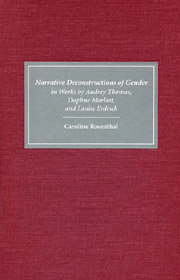Book contents
- Frontmatter
- Contents
- Dedication
- Preface and Acknowledgments
- Abbreviations
- Introduction
- 1 Framing Theories
- 2 “Alice Hoyle: 1,000 Interlocking Pieces”: Identity Deconstructions in Audrey Thomas's Intertidal Life
- 3 “You Can't Even Imagine?”: Monstrous Possibilities of Female Identity in Daphne Marlatt's Ana Historic
- 4 “Her Laugh an Ace”: Narrative Tricksterism in Louise Erdrich's Tetralogy
- Conclusion
- Works Consulted
- Index
Conclusion
Published online by Cambridge University Press: 05 February 2013
- Frontmatter
- Contents
- Dedication
- Preface and Acknowledgments
- Abbreviations
- Introduction
- 1 Framing Theories
- 2 “Alice Hoyle: 1,000 Interlocking Pieces”: Identity Deconstructions in Audrey Thomas's Intertidal Life
- 3 “You Can't Even Imagine?”: Monstrous Possibilities of Female Identity in Daphne Marlatt's Ana Historic
- 4 “Her Laugh an Ace”: Narrative Tricksterism in Louise Erdrich's Tetralogy
- Conclusion
- Works Consulted
- Index
Summary
Knowing that this story, all that is written, can be un/read, uninscribed. The words are stirred, mixed, like pieces of a jigsaw, broken up into their separate shapes and the whole picture lost, left to be reconstructed by another, a different hand.
Aritha van Herk, Places Far from EllesmereAs this study has shown, narrative can be both a prison house that enforces gender stereotypes, and a tool for imagining gender differently. Gender identity is informed by narrative that hides its ideological impetus by concealing the conditions for, and mechanisms of, its own construction. The texts chosen for this study render those mechanisms and thus reverse the naturalizing gestures of narrative, thereby also calling into question constructions of gender. They make possible different narrative constructions of gender that remain, however, visible as constructions because the novels are self-reflexive in their make up. If, as I argue in the framing theory part, identity is a process rather than a trait we achieve and possess, and if gender, sex, and sexuality are the effects of discursive practices and power apparatuses, rather than given categories, different tales of gender offer other imaginative spaces to the reader/subject. Literary stories teach us the gender patterns that shape our lives. The authors in this study show that all stories are gendered in themselves and break down narrative patterns to question underlying assumptions of gender. Gender identity is the effect of formations of power that manifest themselves in narrative.
- Type
- Chapter
- Information
- Narrative Deconstructions of Gender in Works by Audrey Thomas, Daphne Marlatt, and Louise Erdrich , pp. 154 - 160Publisher: Boydell & BrewerPrint publication year: 2003

